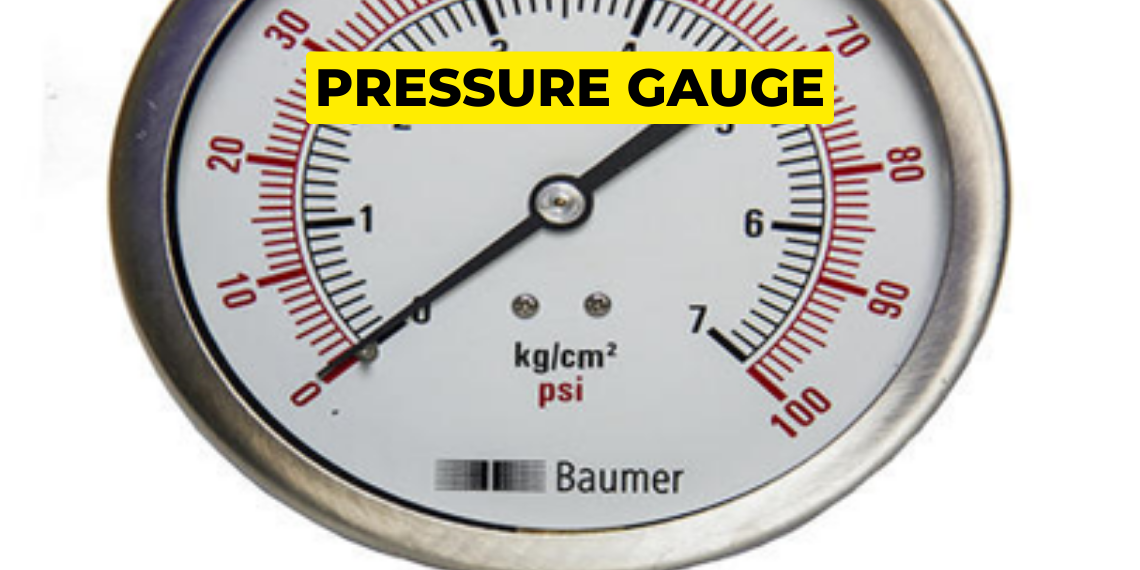Pressure gauge
What is pressure?
Pressure is the force exerted per unit area on a surface. It is typically expressed in units such as pascals (Pa), pounds per square inch (psi), or atmospheres (atm). Pressure can be caused by various types of forces, such as gravitational, electromagnetic, or mechanical forces.
P=F/A P= pressure, F= force, A= area
What is atmospheric pressure ?
Atmospheric pressure is the force exerted by the weight of the atmosphere on the Earth’s surface. It is also known as barometric pressure or air pressure. The Earth’s atmosphere is made up of a mixture of gases, and the weight of this gas mixture exerts a force on the surface of the Earth. This force is called atmospheric pressure and it varies with altitude, temperature, and weather conditions.
It varies from place to place
At sea level = 1 atm.
Top of mount Everest = 0.3326 ATM is the pressure at the peak of Mount Everest.
Atmospheric pressure is inversely proportional to the height.
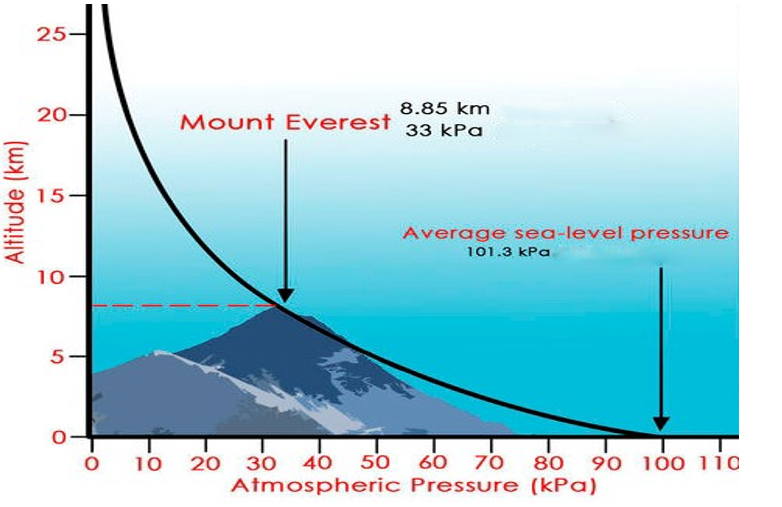
What is gauge pressure?
Gauge pressure is the pressure measured relative to atmospheric pressure. It is the difference between absolute pressure and the local atmospheric pressure.
What is vaccum?
Pressure below atmospheric pressure is called a vacuum.
This means the vacuum is always < atmospheric pressure.
How do we calculate absolute pressure with pressure gauge?
The pressure gauge showing 4 bar pressure on his dial means the absolute pressure is acting on the gauge is 4+1= 5 bar.Because in the pressure gauge dial meter is start from 0, but this 0 is including the acting atmospheric pressure on the pressure gauge. For this reason, absolute pressure will be measured, gauge pressure + atmospheric pressure.
Types of gauge?
There are three types of gauges will be used.
- Pressure gauge.
- Vacuum gauge.
- Compound gauge.
Pressure gauge:-Pressure gauge will always have a positive pressure or > atmospheric pressure. In this gauge always clockwise rotation of the meter.A pressure gauge typically displays the pressure reading in units such as pounds per square inch (psi), bar, kilopascals (kPa), or inches of mercury (inHg), depending on the application and the location where the gauge is used.
Uses on ships:- After the delivery side of the pump, after the compressor etc.
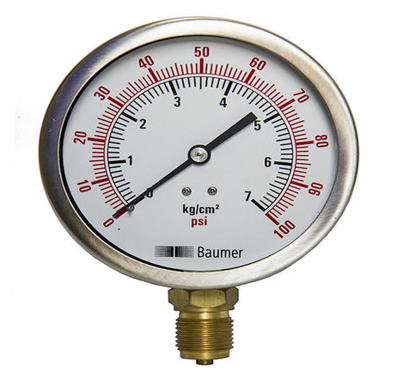
Vacuum gauge:- vacuum gauge is a device used to measure the pressure of a vacuum or low-pressure system or negative pressure(-). Which will always measure the below atmospheric pressure. In a vacuum, the gauge meter is always rotated anti-clockwise. Vacuum gauges typically measure pressure in units such as torr, millitorr, pascals (Pa), or inches of mercury (inHg), or bar, depending on the application and the location where the gauge is used.
Uses on ships:- It is always pleased in the suction side of pumps, engines, and compressors.
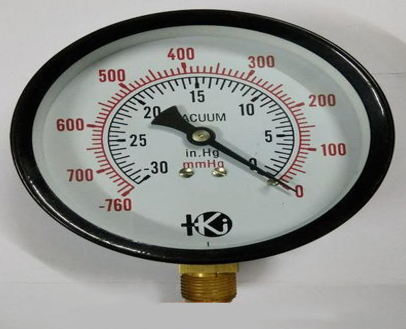
Compound gauge:- A compound gauge is a type of pressure gauge that measures both positive and negative pressures relative to the atmospheric pressure. It consists of a single dial or indicator that displays two scales: one for measuring positive pressure and the other for measuring vacuum or negative pressure. The positive pressure scale typically reads in pounds per square inch (PSI) or bar, while the negative pressure scale reads in inches of mercury (inHg) or millibars (m bar). The gauge has two ports, one for measuring the positive pressure and the other for measuring the negative pressure.
Uses on ships:-Compound gauges are commonly used on ships for various applications such as monitoring pressure in hydraulic systems, monitoring the vacuum in the engine room, monitoring pressure in the air conditioning and refrigeration systems, and monitoring the pressure in the ballast tanks.
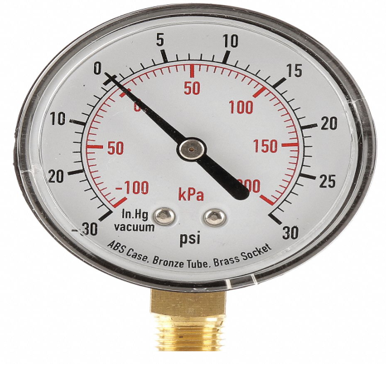
Different Pressure measuring units
1 N/m^2 = 1 Pascal
1 Bar = 1.01 x 10^5 N/m?
1 Bar = 1.01 x 10^5 Pascal
1 kPa (kilo Pascal) = 1000 Pascal
1 MPa (megapascal ) = 10^6 pascal = 10 bars
1 kg/cm^2=1 bar, 100 psi (pounds per square inch)= 6.9 bars
1000 mbar (millibars) = 1 bar
1 Bar = 760mm Hg = 30 inches Hg.
How to order a pressure gauge?
Something you should check first before ordering.
1. Type.
2. Range + unit.
3. Dial dia.
4. Thread & thread dia.
Why glycerine is used in some pressure gauge?
Glycerine Is Added In Some Pressure Gauges The glycerine is a viscous fluid and it provides a damping effect to the needle, hence the needle oscillates less giving accurate readings and decreasing wear and tear, hence increasing the life of the pressure gauge.
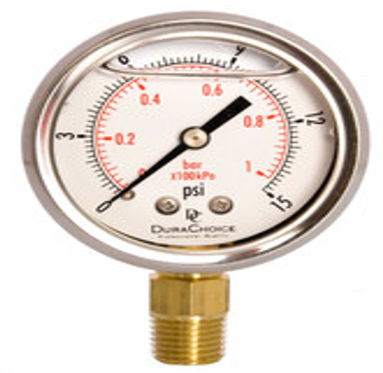
Note:
If you want to learn more about this topic, we suggest checking out our Combo package with the given link https://www.merchantnavydecoded.com/courses/c/ . It’s a great way to dive deeper into the subject through video explanations. This package covers all the important details and presents them in an easy-to-understand format. Watching the videos will help you grasp the topic better and make learning more enjoyable. So, we highly recommend giving our Combo package a try to enhance your knowledge on the subject.
Disclaimer :- The opinions expressed in this article belong solely to the author and may not necessarily reflect those of Merchant Navy Decoded. We cannot guarantee the accuracy of the information provided and disclaim any responsibility for it. Data and visuals used are sourced from publicly available information and may not be authenticated by any regulatory body. Reviews and comments appearing on our blogs represent the opinions of individuals and do not necessarily reflect the views of Merchant Navy Decoded. We are not responsible for any loss or damage resulting from reliance on these reviews or comments.
Reproduction, copying, sharing, or use of the article or images in any form is strictly prohibited without prior permission from both the author and Merchant Navy Decoded.


